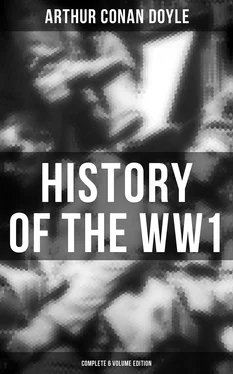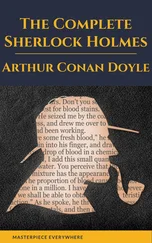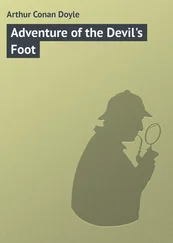Another long lull followed this outburst of activity in the region of the La Bassée Canal, and the troops sank back once more into their muddy ditches, where, under the constant menace of the sniper, the bomb and the shell, they passed the weary weeks with a patience which was as remarkable as their valour. The British Army was still gradually relieving the French troops, who had previously relieved them. Thus in the north the newly-arrived Twenty-seventh and Twenty-eighth Divisions occupied several miles which had been held on the Ypres salient by General D’Urbal’s men. Unfortunately, these two divisions, largely composed of men who had come straight from the tropics, ran into a peculiarly trying season of frost and rain, which for a time inflicted great hardship and loss upon them. To add to their trials, the trenches at the time they took them over were not only in a very bad state of repair, but had actually been mined by the Germans, and these mines were exploded shortly after the transfer, to the loss of the new occupants. The pressure of the enemy was incessant and severe in this part of the line, so that the losses of the Fifth Corps were for some weeks considerably greater than those of all the rest of the line put together. Two of the veteran brigades of the Second Corps, the 9th Fusilier Brigade (Douglas Smith) and the 13th (Wanless O’Gowan), were sent north to support their comrades, with the result that this sector was once again firmly held. Any temporary failure was in no way due to a weakness of the Fifth Army Corps, who were months to prove their mettle in many a future fight, but came from the fact, no doubt unavoidable but none the less unfortunate, that these troops, before they had gained any experience, were placed in the very worst trenches of the whole British line. “The trenches (so called) scarcely existed,” said one who went through this trying experience, “and the ruts which were honoured with the name were liquid. We crouched in this morass of water and mud, living, dying, wounded and dead together for 48 hours at a stretch.” Add to this that the weather was bitterly cold with incessant rain, and more miserable conditions could hardly be imagined. In places the trenches of the enemy were not more than twenty yards off, and the shower of bombs was incessant.
The British Army had now attained a size when it was no longer proper that a corps should be its highest unit. From this time onwards the corps were themselves distributed into different armies. At present, two of these armies were organised. The First, under General Sir Douglas Haig, comprised the First Corps, the Fourth Corps (Rawlinson), and the Indian Corps. The Second Army contained the Second Corps (Ferguson), the Third Corps (Pulteney), and the Fifth Corps (Plumer), all under Sir Horace Smith-Dorrien. The new formations as they came out were either fitted into these or formed part of a third army. Most of the brigades were strengthened by the addition of one, and often of two territorial battalions. Each army consisted roughly at this time of 120,000 men. The Second Army was in charge of the line to the north, and the First to the south.
On February 14 Snow’s Twenty-seventh Division, which had been somewhat hustled by the Germans in the Ypres section, made a strong counter-attack under the cover of darkness, and won back four trenches near St. Eloi from which they had been driven by a German rush. This dashing advance was carried out by the 82nd Brigade (Longley’s), and the particular battalions which were most closely engaged were the 2nd Cornwalls, the 1st Royal Irish, and 2nd Royal Irish Fusiliers. They were supported by the 80th Brigade (Fortescue’s). The losses amounted to 300 killed and wounded. The Germans lost as many and a few prisoners were taken. The affair was of no great consequence in itself, but it marked a turn in the affairs of Plumer’s Army Corps, whose experience up to now had been depressing. The enemy, however, was still aggressive and enterprising in this part of the line. Upon the 20th they ran a mine under a trench occupied by the 16th Lancers, and the explosion produced most serious effects. 5 officers killed, 3 wounded, and 60 men hors de combat were the fruits of this unfortunate incident, which pushed our trenches back for 40 yards on a front of 150 yards. The Germans had followed up the explosion by an infantry attack, which was met and held by the remains of the 16th, aided by a handful of French infantry and a squadron of the 11th Hussars. On this same day an accidental shot killed General Gough, chief staff officer of the First Corps, one of the most experienced and valuable leaders of the Army.
On the 21st, the Twenty-eighth Division near Ypres had a good deal of hard fighting, losing trenches and winning them, but coming out at the finish rather the loser on balance. The losses of the day were 250 killed and wounded, the greatest sufferers being months the Royal Lancasters. Somewhat south of Ypres, at Zwarteleen, the 1st West Kents were exposed to a shower of projectiles from the deadly Minenwerfer , which are more of the nature of aerial torpedoes than ordinary bombs. Their losses under this trying ordeal were 3 officers and 19 men killed, 1 officer and 18 men wounded. There was a lull after this in the trench fighting for some little time, which was broken upon February 28 by a very dashing little attack of the Princess Patricia’s Canadian regiment, which as one of the units of the 80th Brigade had been the first Canadian Battalion to reach the front. Upon this occasion, led by Lieutenants Crabb and Papineau, they rushed a trench in their front, killed eleven of its occupants, drove off the remainder, and levelled it so that it should be untenable. Their losses in this exploit were very small. During this period of the trench warfare it may be said generally that the tendency was for the Germans to encroach upon British ground in the Ypres section and for the British to take theirs in the region of La Bassée.
With the opening of the warmer weather great preparations had been made by Great Britain for carrying on the land campaign, and these now began to bear fruit. Apart from the numerous Territorial regiments which had already been incorporated with regular brigades some fifty battalions in all there now appeared several divisions entirely composed of Territorials. The 46th North Midland and 48th South Midland Divisions were the first to form independent units, but they were soon followed by others. It had been insufficiently grasped that the supply of munitions was as important as that of men, and that the months expenditure of shell was something so enormous in modern warfare that the greedy guns, large and small, could keep a great army of workmen employed in satisfying their immoderate demands. The output of shells and cartridges in the month of March was, it is true, eighteen times greater than in September, and 3000 separate firms were directly or indirectly employed in war production; but operations were hampered by the needs of batteries which could consume in a day what the workshops could at that time hardly produce in a month. Among the other activities of Great Britain at this period was the great strengthening of her heavy artillery, in which for many months her well- prepared enemy had so vast an advantage. Huge engines lurked in the hearts of groves and behind hillocks at the back of the British lines, and the cheery news went round that even the heaviest bully that ever came out of Essen would find something of its own weight stripped and ready for the fray.
There was still considerable activity in the St. Eloi sector south-east of Ypres, where the German attacks were all, as it proved, the preliminaries of a strong advance. So persistent were they that Plumer’s men were constantly striving for elbow room. On March 2 part of Fortescue’s 80th Brigade, under Major Widdington of the 4th Rifles, endeavoured to push back the pressure in this region, and carried the nearest trench, but were driven out again by the German bombs. The losses were about 200, of which 47 fell upon the 3rd, and 110 upon the 4th Rifles. In these operations a very great strain came upon the Engineers, who were continually in front of the trenches at night, fixing the wire entanglements and doing other dangerous work under the very rifles of the Germans. It is pleasing to record that in this most hazardous task the Territorial sappers showed that they were worthy comrades of the Regulars. Major Gardner, Commander of the North Midland Field Company, and many officers and men died in the performance of this dangerous duty.
Читать дальше












